Once again, I found myself flying from
Manchester, NH in to Reno, NV, as I had just slightly over
one year previously. My goal was the same as it had
been then - drive from Reno up past Plush, OR to one of the
high deserts within Oregon where I would spend a few days at
the Dust Devil Mine in search of Oregon
Sunstone! This was actually something to look
forward to, since some time had passed, and I was missing
the thrill of uncovering something hidden in the ground
since it's formation when the earth was much younger.
I must admit though, the long flight of up to 12 hours, the
several hour drive, the 'roughing it' and the extreme
temps should all make me say 'once is enough', but I do find
the isolation, the terrain, the natural beauty, the
roughness and flora/fauna to actually be a draw, as it is
very different from New England.
The Dust Devil Mine, outside of Plush, Oregon, is one of a
number of privately owned mining areas, where one can pay a
fee to dig for Sunstone, a type of Feldspar which frequently
contains copper platelets (called schiller), which gives
Sunstone it's name. There is also a section of public
land where one can also seek Sunstone for free.
The main body colors of this gemstone can be clear, straw,
yellowish, orangy, reddish to even green which is fairly
rare. Some pieces may actually contain more than one
color, to the point where it looks like watermelon, with
green, red and clear. The material can be found in
decent abundance, and anyone entering these areas is
guaranteed to find Sunstone; the finer pieces with color or
schiller, are less common and one might have to dig with
tools in order to find the best material, and again, it is
all luck as to what you might find. My trip in 2007
produced only smaller pieces with some faint schiller with
only one small piece showed a spot of color. When one
calculates that it cost a few thousand dollars to fly from
the East to the West Coast, stay in a hotel in Reno, rent a
car, drive about 6 hours north, dig for several days, drive
6 hours back to Reno, return the rental car and fly back to
the East Coast, one must really strike the motherload in
order to recoup expenses.
When I was there last in July of 2007, the sun was strong
and the temps high during the day. I had joined a
number of those in the trade who facet and sculpt for a
special Dig In event. I had to purchase an air
mattress as well as a new sleeping bag, and I slept in a
small tent for about 4 nights. After a day or two
there, one gets into a schedule. For me, it was up at
about 4:30am just before the sun was up. The coyotes
in the distance had stopped howling and the horizon was
starting to brighten. It was time to put on digging
clothes, crawl out of the tent, walk down to the pit and
work for a few hours before having breakfast. After
breakfast, I would go down into the pit for a few more
hours, insuring that I had some water, suntan lotion, tools
and my sun hat with the flaps over the ears and back of the
neck, looking as if I was on some expedition in
Egypt. Before lunchtime, the heat was too hot to
continue working, so a break for lunch was required.
At this time of the day, it is wise and more comfortable to
stay under anything that provides shade and to talk to the
others who were also digging. Hopefully, a dust devil
would not swirl through camp, throwing everything not tied
around and sending fine particles of sand everywhere; and
that usually includes one's eyes, nose, mouth and
ears. The best part of this was the show and tell -
when others pulled Sunstone from their pockets to show what
they had found. Stories were also told about what some
had seen from others who had been digging. As the
afternoon wears on, one could go back down into the pit at
about 4pm and stay there for another hour or so before
dinner. After dinner, as the sun starts to sink below
the mountains in the distance causing light to fail prior to
the sun actually setting, it was much cooler to work in the
pit. After talking to others for a few hours,
sometimes in complete darkness until 9-10pm in the evening
up by the long house/trailers, it was time to go back to the
tent and retire for the night. This scenario would
play out once again at about 4:30am the next morning.
This trip, in October, would be slightly different with the
change in temperatures. The mining areas usually close
about mid October to late October, depending on the
weather. The elevation is about 4,500 feet and the
mornings were not the nice 50s as in July, but more like
30s, with potential snow if there was going to be any
precipitation. The living out in this area of the
country is dusty, dry, hot or cold and just downright
harsh. Water is very important. Everything, and
I do mean everything, must be hauled/trucked in. I
think the reason why people return here is because of the
beautiful drives through Oregon; the fact that the
countryside changes every 30 minutes; the uniqueness of the
high desert; the fact that one never knows what will be
found when digging. Perhaps the uncertainty of the
hunt and the hope for that very special piece of Sunstone
brings people out to this large dry valley.
From Reno, it is about a 5-1/2 hour drive, with the largest
city that one drives through being Alturas, CA and Lakeview,
OR. One can obtain gas, lodging and food in
Lakeview. I have found this a great place to stop on
the way back from the mine, to wash the car down as it will
be covered in fine dust. From Lakeview, there is still
has a decent drive before one enters the 'town' of Plush,
where one finds a general store and that is pretty much
it. From Plush, there is another 25 or so miles to get
to the sunstone areas, and about 20 miles of this is on dirt
road. Depending on road conditions and the speed that
one can feel comfortable or safe driving, the drive will be
30 or more minutes. One is surrounded by mountains as
you drive along flat lands on dirt roads. You might
not be able to see a car off in the distance, but one knows
that one is there because of the plumb of dust that is
kicked up in back of the car. Dead snakes on the road
can be common, and perhaps the one I saw was a
rattlesnake. I would have normally stopped to look,
but when one stops, the cloud of dirt catches up to the car
and overtakes it. Stopping would mean getting out into
a cloud of dust, breathing it in, etc. Heard that in
years where the jack rabbits are plentiful, that as many as
10 or so could be running on both sides of the road and on
the side of the car. As one gets closer to some that
are in front, they tend to act as if the car is a predator,
and then dart quickly at an angle and unfortunately, into
the path of the car. One of the visitors this year
indicated that one year, many jack rabbits didn't make it to
the other side of the road, as they heard many thuds on the
car as they made their way to the mining area.
Accommodations were different than last year as sleeping in
my very small two person (really like 3/person!) tent on a
newly purchased air mattress and within an advanced
technology sleeping bag, I would be staying in a
trailer. Unfortunately, the trailer had no heat,
running water or a working bathroom, and electricity for
lights was available only when the main generator was
working, which was sometime in the morning until about
lights out (8pm or slightly later). Heating the
trailer was done using the burners of the gas stove.
There was a trick of using a clay flower pot to distribute
the heat. My first night of four, I heated the trailer
with one burner (without the flower pot). The temp in
the morning was about 48F. It didn't feel that cold -
it was a dry cold! It did actually seem warmer than it
would have been back in New England. The remainder of
the nights were spent with two burners on and one of those
had a flower pot. There were two distinct layers of
warmth at different levels of the trailer. When
standing, my shoulders to my head were quite warm, but when
one sat down, the temperature seemed to drop about 20
degrees. With the two burners going, the temperature
in the morning was a toasty 57F!
The pit looked very different than the previous year.
Like a living thing, the pit had grown, progressing west and
also turning 90 degrees towards the north. Most
of the people, as well as myself, were working this westerly
wall. As people got further in to the wall, it
was mandated that heavy equipment come in and break down any
overhangs to protect those digging as debris or the
actual wall could collapse and do serious damage or even
kill a digger. People were finding sunstone with
schiller and some color in this area, as well as the typical
clears and lighter colors such as straw or yellow. I
had brought up a 3-in-1 hand held tool that could be used as
a jack hammer - one needs a small generator. It is
interesting, as others also had similar tools and the small
(and fairly heavy too) same brand name generator was quite
common for those using power tools. I borrowed tools
from the Dust Devil, which included a shovel, bucket, small
rock hammer/pick, screen. I had brought my own work
gloves which as pretty much a necessity as it helps with
callouses, but I did have an area of skin removed from my
hand due to constant friction, and the fact that there were
a few prickly pear cactus needles still in my gloves from
home, didn't help, as they worked their way into my skin,
irritating me during my work and causing swelling after all
was said and done (Yes, there is a cactus that
survives the winter in New England. It is a variety of
prickly pear which has wonderfully large yellow blossoms and
actually does well, though it dehydrates during the
winter). There are many areas of decayed rock to work,
so one removes what they can and then screens it. Once
the smaller material has fallen through, one can hold the
screen up to the sky to see if there is anything
transparent, which would be sunstone. Many of the
Sunstones are covered in dust, dirt, etc. so looking down on
them, they look like the other rocks. Frequently, when
working, sunstones which are located in situ (in place) can
typically be readily seen when uncovered. One of the
most incredible sights that I saw during my digs happened
in about mid morning. The sun wasn't all that
high due to the time of the year and the fact that I was
down in the pit. I was scraping the top of a small
overhang when a sunstone dropped down and positioned itself
on top a pile of debris. The sunstone contained quite
a bit of copper schiller, and the sun was hitting it just
right to produce this glowing copper color in the sunlight.
I was the first person to see this natural beauty since it's
formation 6.5 million years ago!
The night before leaving Reno for the Dust Devil, there was
talk of a cold front coming down from Alaska. They
were predicting snow at elevations over 5,000ft.
Before it got dark on my first full day of digging, there
were very fine flakes falling from the sky. I awoke
the next morning to find a few inches of snow on the
ground. It was a different snow than what is normally
seen back in New England. It was sort of roundish,
looks like it was hard, but it was also fluffy at the same
time. Digging for Sunstone when the ground was covered
in snow was not that bad. It was difficult to walk
around the pit, as one couldn't see the best rocks to step
on as they were under just enough snow so as not to know if
you should step on a particular rock or not. The
temperature was fine once the sun came out, plus when one
was working, it really did not seem cold. Again, since
the humidity is very low, the temp that I was working at
here felt warmer in Oregon, than if I were back home with
higher humidity and at the same temperature. The one
draw back to having some snow on the ground is when it
starts to melt. It wasn't getting muddy, but the mix
of snow and dirt would clog up ALL the treads in one's
boots, and make it so the tread was useless and slippery,
not to mention that if it came off when in a trailer, it
would have to be cleaned up. I did bring rain gear
that I had purchased for my white water rafting trip in the
Grand Canyon back in 2004. I thought that I would work
in the rain if necessary, as my time at the Devil was
limited. I never needed it, but now that I think of
it, attempting to dig in the rain, with all that debris,
soil, sand, etc. it is sure to turn to mud and I can
honestly say that it would be miserable to be there
attempting to work in that kind of a mix.
Needless to say, unlike my trip last July, there were
actually very few people digging. Most of the people
were part of the Dust Devil. Everyone eventually goes
into the long house where there is a small kitchen,
refrigerator, running water, and a wood stove. There
is usually someone there to sit and chat with, and getting
out of the wind and cold feels good. In the past, food
was served - breakfast, lunch and dinner, at a small price.
(This is no longer an option as they stopped doing meals)
This was great for a person, such as myself, who has
traveled 3000 miles and doesn't have a working trailer,
stove, and most importantly, food! The trailer I was
in provided shelter from the cold, provided some heat, as
well as a stove to boil water. To make things easy, I
had freeze dried food frequently used by those who hike and
camp. All I had to do was heat up water to boiling
(which didn't take too long due to the altitude, but the
temp of the water was not exactly what I would call hot),
add the hot water to the foil pouch containing whatever was
for breakfast or dinner, seal it and wait about 5
minutes. Not the most tasty food, but in this type of
environment under my existing conditions, it worked.
Lunch was trail mix, fresh fruit and dried fruit that I had
brought in from Reno, as well as fruit juice, gatorade and
most importantly, water.
In just over 3 days of digging, about 7 hours per day, I
found Sunstone that was clear, contained schiller and this
time, unlike 2007, there were pieces that contained
color. A few pieces contained heavy schiller.
Sunstone is tricky and though one might think they have a
wonderful red or schiller piece (or both!), closer
examination will probably prove that there are some
inclusions or even a cleavage plane that will cause an issue
with getting a large gemstone. Also, the orientation
of the schiller or the actual thickness of the piece will
cause issues and make the piece much smaller in its faceted
state or not even useable. As indicated above, due to
inclusions, thickness, orientation, cleavage issues, etc.
the number of pieces that can produce All That Glitters high
quality gemstones, is very limited. Like most rough
gemstones, quantity is very different than quality, and the
fine material is a very small fraction of 2% which is the
average said to be associated with gemstone rough when
compared to all the gem material removed from a mining
location. Of all the pieces we did return with, my
master cutter and I looked at every piece, choose one,
trimmed it, and he faceted a nice orangy 3.90ct squarish
cushion. This piece has schiller, but not enough to
actively see the glitter or affect the transparency.
Currently, this gemstone may appear in the 2nd edition of a
book on gemstones by Keith Wallis.
One pays the Dust Devil for the better/best material that is
found. The clears are free. So, Don will sit
down with someone before they leave to go over their
material and figure out what is there and what the cost will
be. No one has to take the material they found, but
the better material has a value and it is up to the digger
to determine if it is worth it for them, otherwise, the mine
gets to keep what is found. As Don said a few times -
"Go out there and make me some money!". Yes, digging
is free and it is nice of the Dust Devil to allow anyone
onto the property to dig. They have bills to pay, and
to keep that place open costs money. Those who dig
help to keep the mining business operating by the fees paid
for the better material that they find.
The mine doesn't entirely depend on collectors, cutters or
lapidarists to keep the mine open. They have all the
heavy equipment that one expects at a mine. In fact,
they even have an optical sorter, one of only a few in the
world. They load a conveyor belt with rock containing
sunstone. The belt runs at a constant rate and drops
material to a lower level. An infra-red scanner views
the material, and when a transparent fragment of sunstone is
seen, multiple air jets blow that particular piece off to
the side to be collected. The other material continues
to run on the belt and will be discarded.
Many thanks to the owners and crew of the Dust Devil
Mine. To learn more about the Dust Devil, visit the
following link:
http://www.dustdevilmining.com/
Below are photos from the October 2008 excursion to the Dust Devil described above:
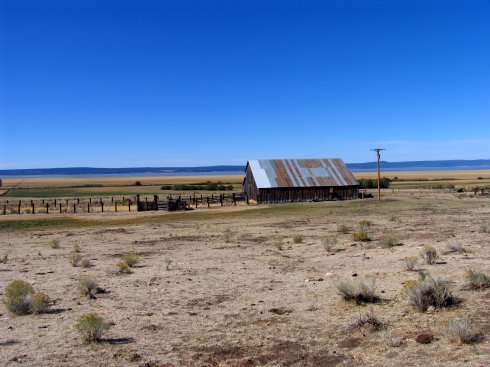 |
| Barn on the drive up
to Plush - near the CA/OR border |
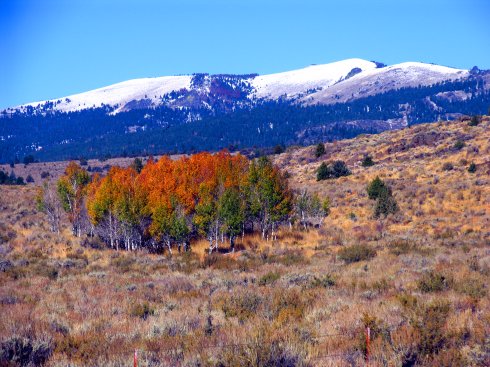 |
| On the main road
heading into Plush |
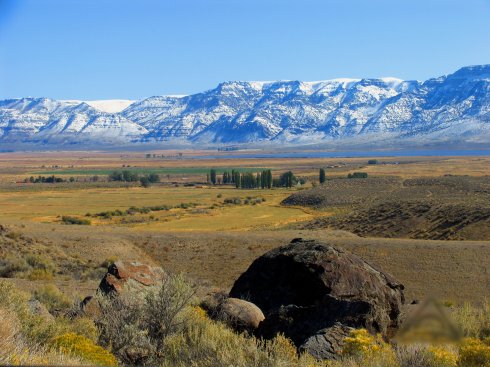 |
| The town of Plush
from a distance |
 |
| Not the best signage,
but something. The GPS that I was using was
useless as it showed that I was not driving on any
existing roads. The GPS might have been set up
to avoid dirt roads, but I would have thought that
dirt roads would still be visible. |
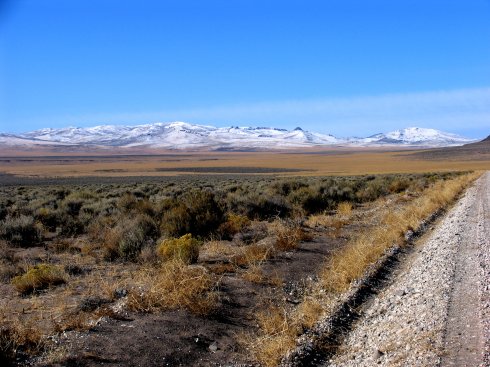 |
| Pretty countryside,
but quite desolate |
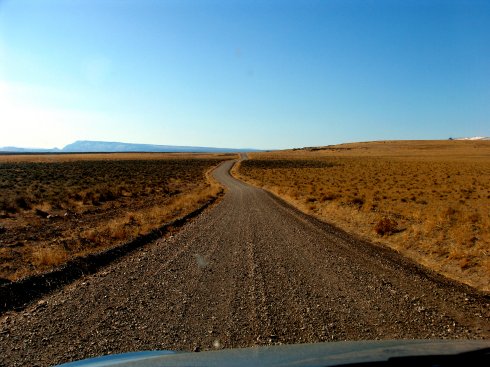 |
| The dirt road was decent in October 2008, as it had been graded/repaired |
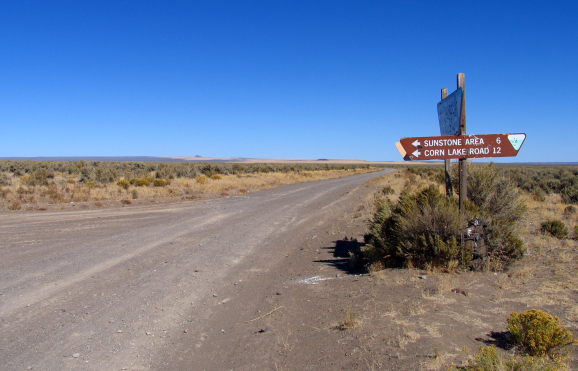 |
| Six more miles of dirt road to go to the sunstone collecting areas... |
 |
| Public Sunstone Area,
just past the Dust Devil Mine entrance |
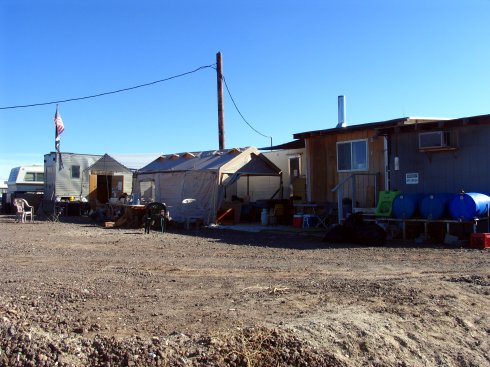 |
| The long house and
trailers - Dust Devil |
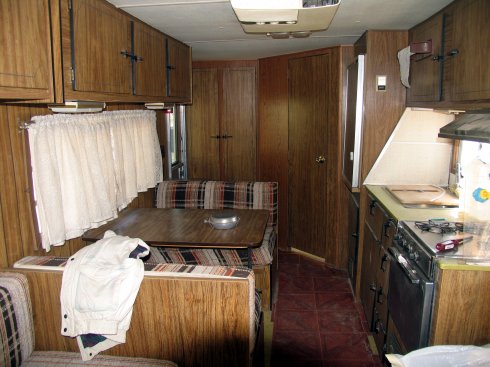 |
| Looking to the front
door of the trailer that was called home for 4
nights |
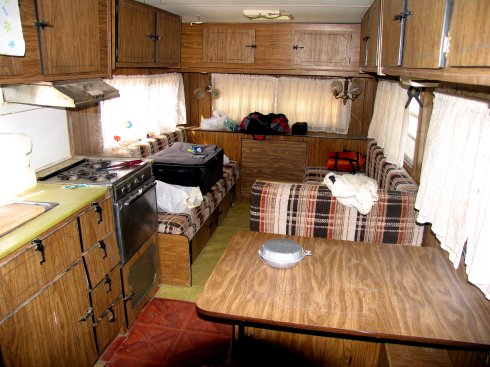 |
| Looking towards the
back of the trailer |
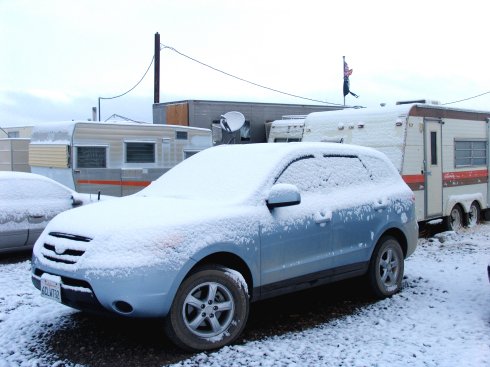 |
| Waking up to snow the
following morning after my arrival |
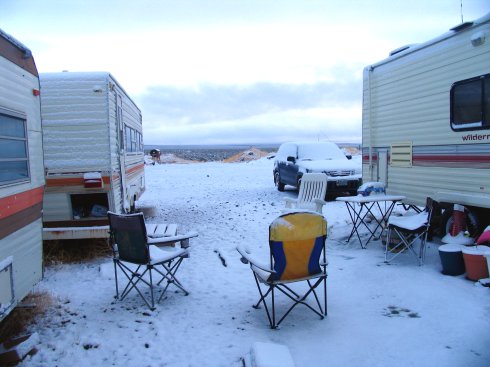 |
| Not a day to sit in
the sun to get warm - no sun, and not warm.... |
 |
| The pit extends down
below out of sight |
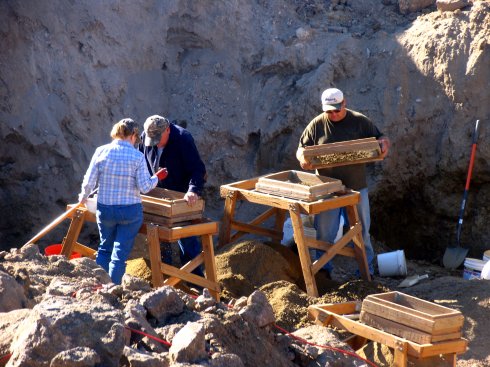 |
| Diggers in the pit -
west wall |
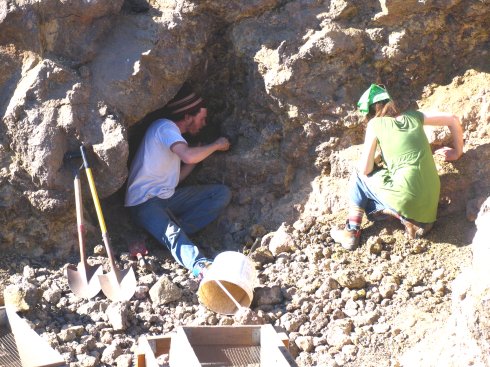 |
| More diggers |
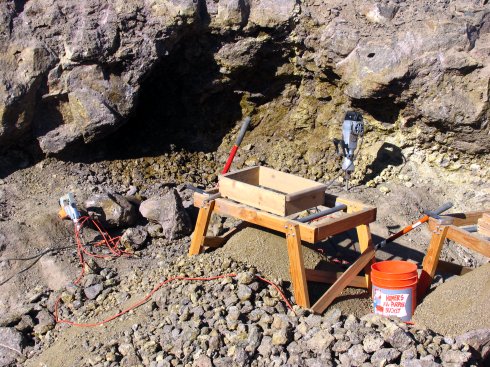 |
| The claim that I was
working during my stay - west wall. The drill
on the right is a 30lb jackhammer |
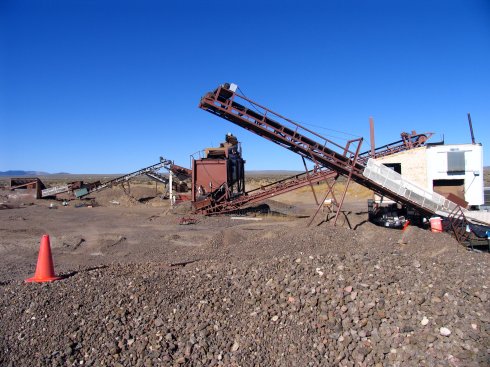 |
| Mechanized mining |
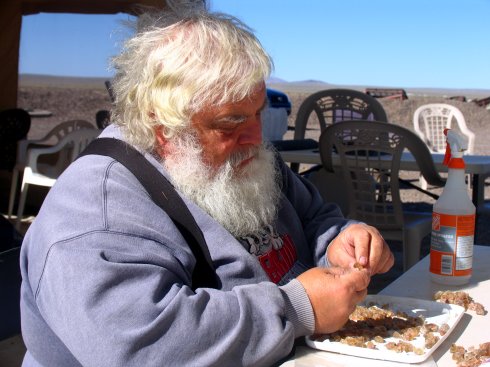 |
| Don inspecting,
grading and pricing a diggers find |
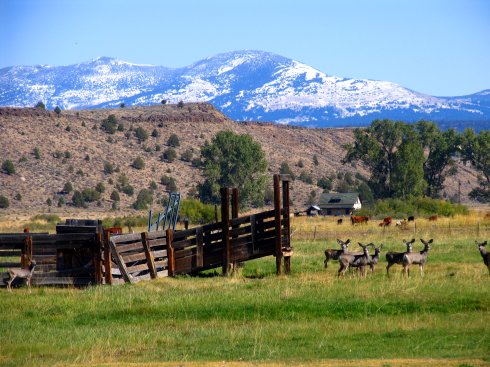 |
| In the Altura area on the drive back to Reno |
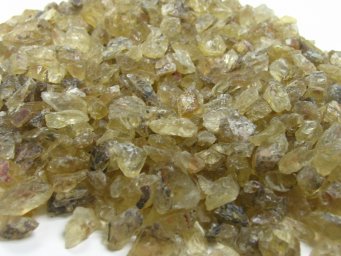 |
| Clear material that was found - quantity, but not quality |
| |
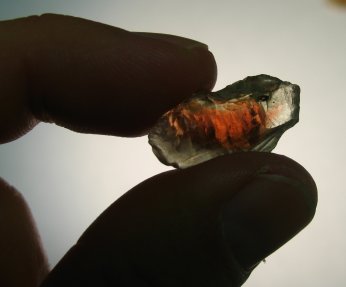 |
| Looks great, but there are a number of issues which would allow only a small gemstone to be realized. Not something that All That Glitters would facet. |
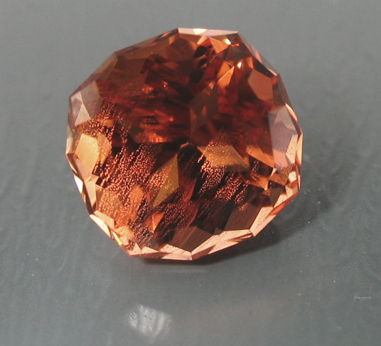 |
| The only Sunstone
that our master cutter thought was worth his
time/fees to facet from ALL the pieces of sunstone
that were found during 4 days of digging. This
is a 3.90ct gem, with a good orangy body color and
schiller in parts - but the schiller is not that
obvious and does not interfere with the
beauty. Yes, anyone going to this area of
Oregon will find Sunstone - absolutely. The
only question is whether anything of a high value
will be found to offset the cost of expenses.
SOLD! (Store - NC) |
Photographs by: L. Allen Brown, All That Glitters
(Copyright: LAB/ATG)